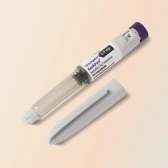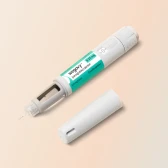For people new to Orlistat, a common question is: how should I change my diet?
Because of how Orlistat acts on the gut, it is important to be mindful of what you’re eating while using it. Plus, like other weight loss medicines, Orlistat is meant to be used alongside a nutrient-rich, reduced-calorie diet.
We know that might sound like a lot to get your head around. But don’t worry—the advice here is pretty straightforward. We’ve broken it down for you below.
What is Orlistat?
It’s a weight loss pill that prevents around one third of the fat you eat from being digested. This undigested fat is then passed out in your stools.
Importantly, Orlistat is most effective when it supplements a healthy diet and regular exercise. It might not work as well if you use it on its own.
What to eat on Orlistat
Okay, but what does a healthy diet on Orlistat look like?
There’s a few aspects to this. One is eating fewer calories than you burn each day (aka a reduced-calorie diet). Another is reducing your fat intake.
Calorie reduction
Creating a calorie deficit is fundamental to weight loss with orlistat. Most healthcare providers recommend reducing your daily caloric intake by 500-600 calories below your maintenance level. For many adults, this means consuming approximately 1,400-1,700 calories per day, but your specific needs may vary based on factors like age, sex, weight, and activity level.
How many grams of fat per meal are safe with orlistat?
To minimise gastrointestinal side effects while taking orlistat, it's crucial to limit your fat intake. The general recommendation is to keep your total daily fat intake below 30% of your total calories, distributed evenly across your meals.
For a 1,500-calorie diet, this means consuming no more than about 50 grams of fat per day. To distribute this evenly:
- Main meals (breakfast, lunch, dinner): Aim for 15 grams of fat or less per meal
- Snacks: Keep to 3 grams of fat or less per snack
As a general guideline, look for foods with less than 5 grams of fat per 100g serving when checking nutrition labels.

Finally, make sure you’re eating a nutritionally-balanced diet that supports weight loss. Here, you want to be eating foods with fewer calories but that make you feel full, and ensuring you’re getting all the vitamins and minerals your body needs to function at its best.
Are there vegetarian/vegan meal options for orlistat?
Yes, vegetarian and vegan diets can work well with orlistat as they're often naturally lower in fat than meaty diets. Here are some plant-based protein options that are compatible with orlistat:
- Tofu
- Tempeh
- Seitan
- Legumes
- Nutritional yeast
- Low-fat plant milks
What quick snacks are orlistat-friendly?
Snacking can be challenging on orlistat, but these low-fat options (under 3g fat per serving) make good choices:
Low-Fat Snacks (<3g fat per serving)
- Fresh fruit (apples, berries, oranges)
- Fat-free yogurt (plain or with fresh fruit)
- Rice cakes with fat-free cottage cheese
- Vegetable sticks with fat-free tzatziki or hummus
- Fat-free jelly/gelatin
- Air-popped popcorn (without butter)
- Low-fat rice pudding made with skimmed milk
- Baked apple with cinnamon (no butter)

Sample 7-day Orlistat diet plan
To reiterate: your provider should be your first port of call in making a plan that’s tailored to you.
But to give you a rough idea of what a week of eating on Orlistat could look like, we’ve put together the below. This 7-day orlistat diet plan assumes a daily calorie intake of roughly 1,4500 to 1600, where about half the calories come from carbs, 25 to 30% from protein, and no more than 30% from fat.
Energy requirements vary depending on a number of factors, including activity levels, age and gender. For tailored recommendations on energy requirements, it’s always best to consult a nutritionist or dietitian.
And FYI: in the UK, one portion of fruit or veg is 80g.
Weekly Meal Plan
Monday
- Breakfast: Wholewheat bagel with 1 tbsp low-fat Greek yoghurt, one orange.
- Snack: Wholewheat slice of toast with 2 tsp nut butter and one portion of berries.
- Lunch: 50g wholewheat macaroni, one portion mixed vegetables, ⅛ cup low-fat cheese, and one portion of boiled cauliflower.
- Snack: 8 wholewheat crackers with 4 tbsp low-fat hummus and one portion of boiled broccoli.
- Dinner: Wholewheat turkey sandwich with 1 tbsp light mayo, apple, and mixed salad with tomatoes and 1 tsp of olive oil.
Tuesday
- Breakfast: Wholewheat bagel with 2 tsp nut butter, one kiwi.
- Snack: Smoothie with banana, berries, 2 tbsp oats, protein powder or low-fat Greek yoghurt, and skimmed or soya milk.
- Lunch: Baked cod fillet with one portion of green beans, one portion of asparagus, 50g brown rice or couscous, and 1 tsp of olive oil.
- Snack: 8 wholewheat crackers with 4 tbsp low-fat hummus and one portion of boiled broccoli.
- Dinner: Medium-size baked potato with tinned tuna (mixed with 1 tbsp light mayo and ½ stick celery), mixed salad with tomatoes and 1 tsp of olive oil. One banana.
Wednesday
- Breakfast: 4 tbsp oats cooked with 6 tbsp skim milk, ½ scoop protein powder, and ½ banana.
- Snack: One portion of cucumber, sliced, with canned tuna on top.
- Lunch: Grilled chicken breast with 2 tbsp balsamic vinaigrette, four cooked beetroots, 2 tbsp cooked lentils, and 50g brown rice or couscous.
- Snack: Clementine with 1 tbsp low-fat Greek or soya yoghurt.
- Dinner: Microwaved sweet potato with chicken breast and 2 tbsp low-fat pesto, served with cranberry, spinach, and walnut side salad.
Thursday
- Breakfast: Wholewheat bagel with 1 tbsp low-fat Greek yoghurt and one portion of berries.
- Snack: 100g low-fat Greek yoghurt with 15 grapes.
- Lunch: Wholewheat tuna sandwich with 1 tbsp light mayo, half a stick of diced celery, salad with tomatoes and 1 tbsp olive oil, and one kiwi.
- Snack: 4 wholewheat crackers with 2 small slices of low-fat cheese, one portion of boiled broccoli, and one portion of boiled cauliflower.
- Dinner: 50g wholewheat macaroni with one portion of mixed vegetables, ⅛ cup low-fat cheese, and one portion of boiled green peas.
Friday
- Breakfast: 4 tbsp oats cooked with 6 tbsp skim milk, ½ scoop protein powder, and ½ banana.
- Snack: Apple with 2 tsp of nut butter.
- Lunch: Ground turkey rice bowl (wholewheat, 40g) with one portion of green beans, tomato, and cucumber salad.
- Snack: Small handful of sunflower seeds and one banana.
- Dinner: ½ microwaved sweet potato, chicken breast, 4 tsp light BBQ sauce, and a mixed greens salad with 1 tsp of olive oil.
Saturday
- Breakfast: Egg white and spinach scramble with one slice of wholemeal toast.
- Snack: One portion of cucumber, sliced, with canned tuna on top.
- Lunch: Grilled chicken breast with 2 tbsp balsamic vinaigrette, four cooked beetroots, 2 tbsp cooked lentils, and 50g wholegrain rice, pasta, or couscous.
- Snack: Clementine with 1 tbsp low-fat Greek or soya yoghurt.
- Dinner: 30g wholewheat pasta with chicken breast and ⅓ cup tomato sauce, mixed green and tomato salad, and 1 tsp of olive oil.
Sunday
- Breakfast: Wholewheat bagel with 2 tsp nut butter and one apple.
- Snack: 4 tbsp of oats with 6–8 tbsp of skimmed or soya milk. Optional: 1 tsp sweetener (e.g., honey) or protein powder.
- Lunch: Baked cod fillet with one portion of raw bell peppers, one portion of boiled cauliflower, and 50g brown rice or couscous.
- Snack: 4 wholewheat crackers with 1 tbsp low-fat hummus and about 15 grapes.
- Dinner: Wholewheat turkey sandwich with 1 tsp light mayo, one banana, and mixed salad with tomatoes and 1 tsp of olive oil.

Groceries to buy
Here's a basic grocery list to help you prepare for the 7-day orlistat diet plan:
Proteins
- Skinless chicken breast
- White fish (cod, haddock)
- Egg whites or egg substitute
- Fat-free Greek yogurt
- Fat-free cottage cheese
- Tofu
- Lentils and beans
Carbohydrates
- Oatmeal (plain, not instant)
- Brown rice
- Whole grain bread
- Whole wheat pasta
- Sweet potatoes
- Quinoa
- Rice cakes
Fruits and vegetables
A variety of fresh produce including berries, apples, oranges, leafy greens, bell peppers, tomatoes, cucumbers, broccoli, carrots, and other seasonal vegetables.
Condiments and Other Items
- Fat-free salad dressings
- Herbs and spices (basil, oregano, cinnamon, etc.)
- Vinegar (balsamic, apple cider)
- Mustard
- Low-sodium broth
- Cooking spray (instead of oil)
Foods to avoid on Orlistat
The advice is pretty clear here: avoid foods that are high in fat. These can bring on side effects or make any existing symptoms worse. To manage this effectively, following an Orlistat diet plan can help reduce potential side effects and support weight loss while ensuring a balanced, low-fat intake.
As a general rule, foods should have less than 5g of fat per 100g (this information will be on the food label).
You’ll also want to steer clear of other foods that will work against your health goals. Like those that will give you a rush of energy but won’t fill you up: think processed foods high in sugar (cookies, cakes, soft drinks) and refined grains (white bread, potatoes).
Practical tips for success on Orlistat
There are a few other things that factor into a successful Orlistat diet plan.
Portion control
A good diet plan will include personalised guidance on this. But some general advice here is to measure your ingredients (including cooking oils) so you stick to the serving size, use smaller plates to reduce your portions, and skip seconds.
Healthy meal prep
How you cook your food makes a difference, too. Boiling, pan-frying, and roasting are all healthier than frying with fats—as is eating your fruit and veg raw. And if you’re cooking vegetables, steaming, microwaving or using an air fryer can help them retain their nutritional content.
Staying motivated
But what’s most important is sticking to your new routine. If your motivation dips, there’s a chance you’ll stray from your path.
We’ve given some more thorough advice about weight loss and motivation here, but broadly: it can help to keep tabs on how far you’ve come (maybe you would keep a diary) and celebrate every single win, no matter how small. You deserve it!
Is Orlistat right for you?
We’re glad you asked. Your weight loss journey is as unique as you are, and there’s no one-size-fits-all approach.
That’s why our weight loss programme includes personalised advice and support from our team of expert coaches. They’ll work with you to create a plan of action—and will be there to cheer you on at every step.
You’ll also get weight loss medications —either Orlistat, or weight loss injections Saxenda, Wegovy, or Mounjaro —posted to you each month.
Our clinicians will recommend which medicine they think is best for you when you sign up. So, if you are wanting to start your Orlistat weight loss programme (or try any other medicines), fill out this short form to see if you’re eligible.











